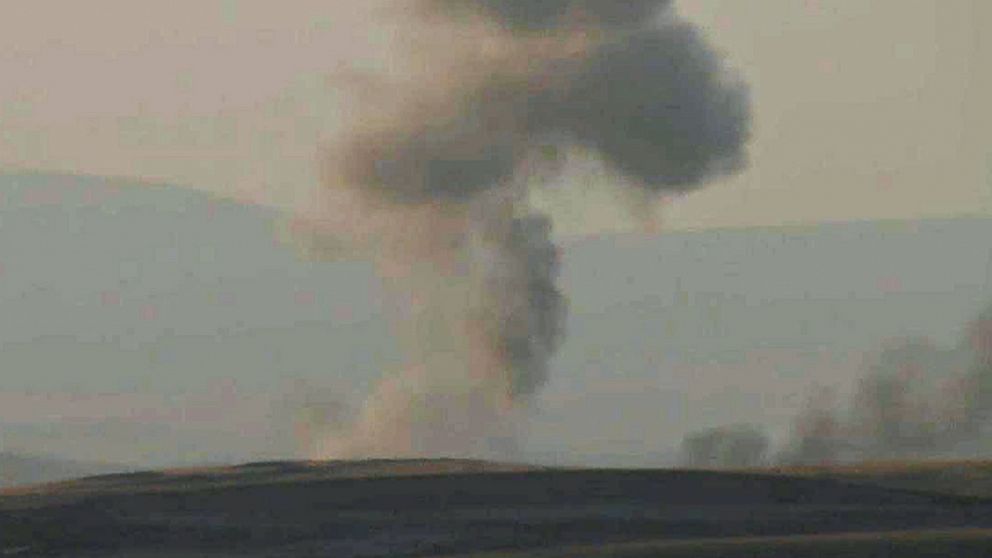US Carries Out More Airstrikes Against ISIS in Iraq
Administration has no interest in carrying out broad-based operation.
-- The United States military has carried out three rounds of airstrikes today against ISIS militants in Iraq in its renewed effort to bolster the Iraqi and Kurdish forces from the Islamic militants.
The strikes targeted ISIS fighters, a stationary convoy, mortars and artillery, according to statements from Pentagon's press secretary Rear Adm. John Kirby.
An armed drone struck an ISIS mortar position shortly after 10 a.m local time. A follow up attack was launched on the ISIS fighters when they returned to the location "and successfully eliminated," Kirby said.
Iraq, Syria and ISIS: What It All Means
The Dramatic Gains ISIS Has Made in Iraq
Why Control of a Terrifying Dam in Iraq Is Life or Death for Half Million People
A little more than one hour later, four F/A-18 aircraft hit a stationary convoy of seven vehicles and a mortar position near Erbil, the capital of the Kurdish autonomous region. According to Kirby, the fighter jets conducted two passes, dropping a total of eight bombs on the target, wiping out the mortar and convoy.
The two strikes came after an ealier attack reported this morning. Kirby said two fighter jets dropped 500 pound laser guided bombs on a mobile artillery piece. Kirby said the artillery was being "used against Kurdish forces defending Erbil, near U.S. personnel."
The fighter jets that dropped the bombs came from the USS Bush aircraft carrier in the Persian Gulf, according to the U.S. Navy.
The attacks come one day after President Obama authorized air strikes in Iraq if necessary.
"We intend to stay vigilant, and take action if these terrorist forces threaten our personnel or facilities anywhere in Iraq," Obama said.
Obama said there will be no U.S. troops on the ground.
"I will not allow the United States to be dragged into fighting another war in Iraq. And so even as we support Iraqis, as they take the flight to these terrorists, American combat troops will not be returning to fight in Iraq," Obama said.

It has been nearly three years since U.S. forces left Iraq, three years since Obama announced the war there was over. The last convoy of U.S. soldiers left Iraq in December 2011.
Administration officials believe the Iraqis are best-suited to deal with the threat of ISIS, the Islamic State of Iraq and Syria, over the long term.
"We're laying down a marker here that even though [ISIS] is not penetrating Erbil, just their presence on the periphery, and the potential threat they pose, could lead us to take action if the targets present themselves," an official told ABC News.
U.S. forces are conducting a difficult and dangerous humanitarian mission, with three U.S. Air Force cargo jets escorted by two F-18 fighter jets dropping critical supplies. In a race to stop a catastrophe, thousands of families who fled to the top of a mountain in Sinjar now face a worrisome predicament, battling blistering heat, pleading that there is no water or bread. Nearly 20 children have already died.
They are trapped 3,000 feet up with no escape.
Down below, ISIS terrorists have taken over their homes, warning of a slaughter if they return.
The U.S. aircraft dropped 5,300 gallons of water and 8,000 ready-to-eat meals.

Senior administration officials said air drops and humanitarian aid will continue "as we see need," and the administration expects that need to continue.
The White House believes any action would be consistent with international law, because U.S. input was requested by the Iraqi government. Additionally, the administration believes that the president has the legal authority under the Constitution to act to protect U.S. citizens.
At this point, the United States is not evacuating Americans from Erbil, confident that the consulate is safe, administration officials said.
The Federal Aviation Administration issued a notice today prohibiting U.S. operators from flying in airspace over Iraq "due to the hazardous situation created by the armed conflict."
Last week the FAA restricted flights at or below 30,000 feet.
Get real-time updates as this story unfolds. To start, just "star" this story in ABC News' phone app. Download ABC News for iPhone here or ABC News for Android here.




